While SEO is equally as crucial to the B2B (business-to-business) world as it is for B2C (business-to-consumer) companies, B2B SEO involves a different set of tactics.
Why is that?
It’s due to the difference in audience, as Google’s search algorithms work the same for B2B companies as they do for B2C.
In other words, classic SEO factors like proper keyword optimization, high-quality content, fast page speed, and authoritative backlinks will still help you climb to the top of the SERPs as they always would.
Yet, instead of creating content that caters to as many consumers in your target audience as possible, your content exists to influence key decision-makers at other companies (such as sales managers, CEOs, marketing managers, etc.).
For B2B SEO, you’ll need to create content that’s more tactical and technical in nature, as your goal is to convince business leaders to use your products and services over your competitors.
That usually consists of ultimate guides, buying guides, whitepapers, downloadable templates, and webinars covering topics that matter to your B2B audience.
Also, B2B conversions typically take longer than B2C, as more than one decision-maker will have to give your product the green light before a business will adopt it.
In fact, the average B2B buyer will consume 8 pieces of content from your website before speaking to a salesperson.
That means your content needs to really stand out from the crowd, so read on to learn how to master B2B SEO.
B2C vs. B2B SEO: What’s the Difference?
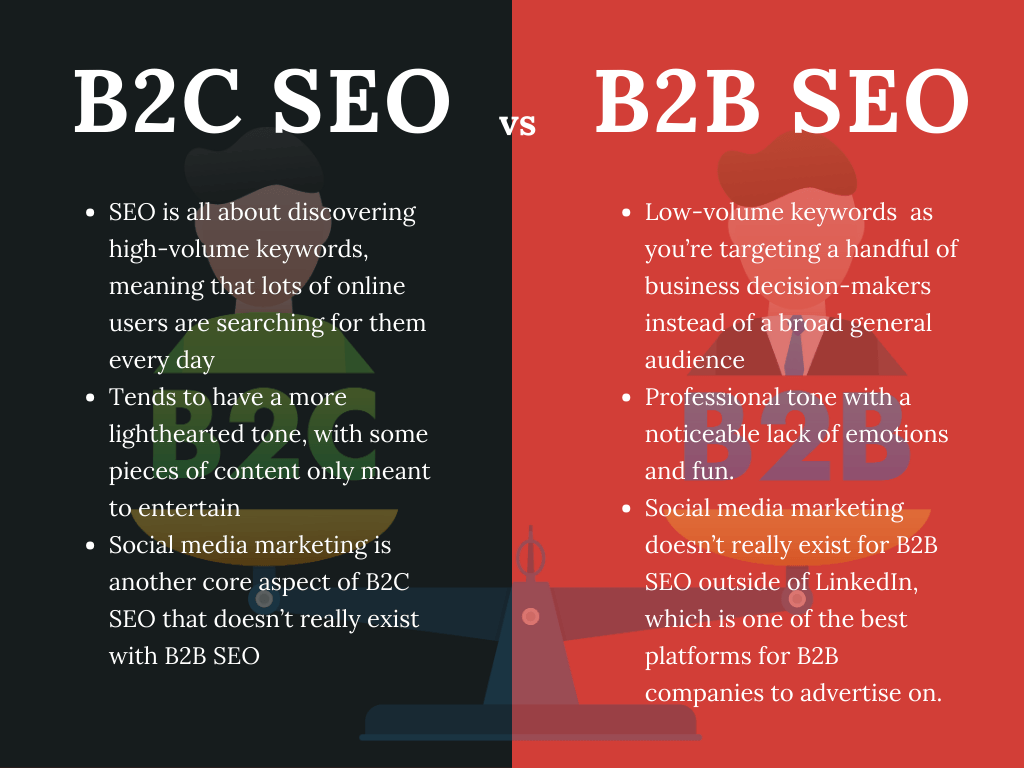
There are more differences between B2C and B2B SEO than you might think, even though they both involve the same Google Search algorithms.
For example, B2C SEO is all about discovering high-volume keywords, meaning that lots of online users are searching for them every day.
The idea is to generate as much organic traffic from your target audience as possible to gain leads and conversions.
Also, B2C content tends to have a more lighthearted tone, with some pieces of content only meant to entertain.
Social media marketing is another core aspect of B2C SEO that doesn’t really exist with B2B SEO (outside of LinkedIn, which is a must for any B2B company).
B2B SEO focuses on low-volume keywords instead, as you’re targeting a handful of business decision-makers instead of a broad general audience. That means the keywords you target don’t need astronomically high search volume to be viable for your business.
B2B content tends to have more of a professional tone with a noticeable lack of emotions and fun.
That’s not necessarily a bad thing, as your content has different goals than B2C – namely, to convince business owners of your worth as a supplier/thought leader.
Social media marketing doesn’t really exist for B2B SEO outside of LinkedIn, which is one of the best platforms for B2B companies to advertise on.
In addition to blogging on your website, you should also release blogs through LinkedIn to ensure you’re reaching as many decision-makers as possible.
How to Conduct a B2B SEO Campaign
While B2B SEO has some noticeable differences from B2C, the fundamentals of search engine optimization remain the same.
You’ll still need to conduct keyword research to guide your content strategy, and on-page and technical SEO factors still apply.
For example, if Google can’t properly crawl and index your most important content, it won’t appear in the SERPs.
Check out our extensive technical SEO and on-page SEO guides to learn more about how to optimize your web pages correctly.
For now, here’s an overview of the unique steps you’ll need to take to conduct a B2B SEO campaign.
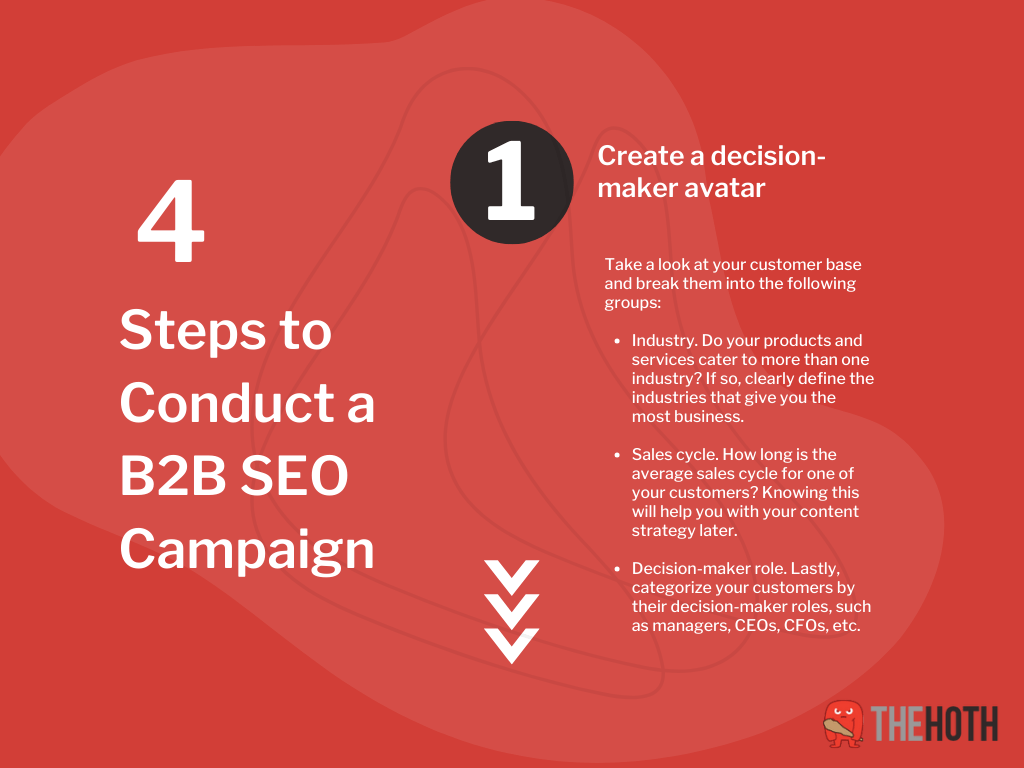
Create a decision-maker avatar
Before you start looking up keywords, you need to know more about the types of decision-makers you need to appeal to.
First, you must determine who to target at each business, such as CEOs, marketing managers, or procurement managers.
How can you find out?
It will depend on the type of B2B products and services that you deliver, as well as your current customer base.
For instance, if you provide white-label products for grocery stores, you’ll want your content to cater to food procurement managers. Additionally, take a look at your customer base and break them into the following groups:
- Industry. Do your products and services cater to more than one industry? If so, clearly define the industries that give you the most business.
- Sales cycle. How long is the average sales cycle for one of your customers? Knowing this will help you with your content strategy later.
- Decision-maker role. Lastly, categorize your customers by their decision-maker roles, such as managers, CEOs, CFOs, etc.
Once you’ve got all this information ready, you can build your decision-maker avatar (also called buyer persona).
What’s that?
It’s a fictional character that embodies the traits of the essential decision-makers you need to cater to.
Your avatar should be fully fleshed out with a name, age, professional title, likes, dislikes, hobbies, interests, and more.
That means you’ll need to research your target audience to learn more about them. We recommend scouring their LinkedIn profiles, other social media platforms, and any forums that they frequent.
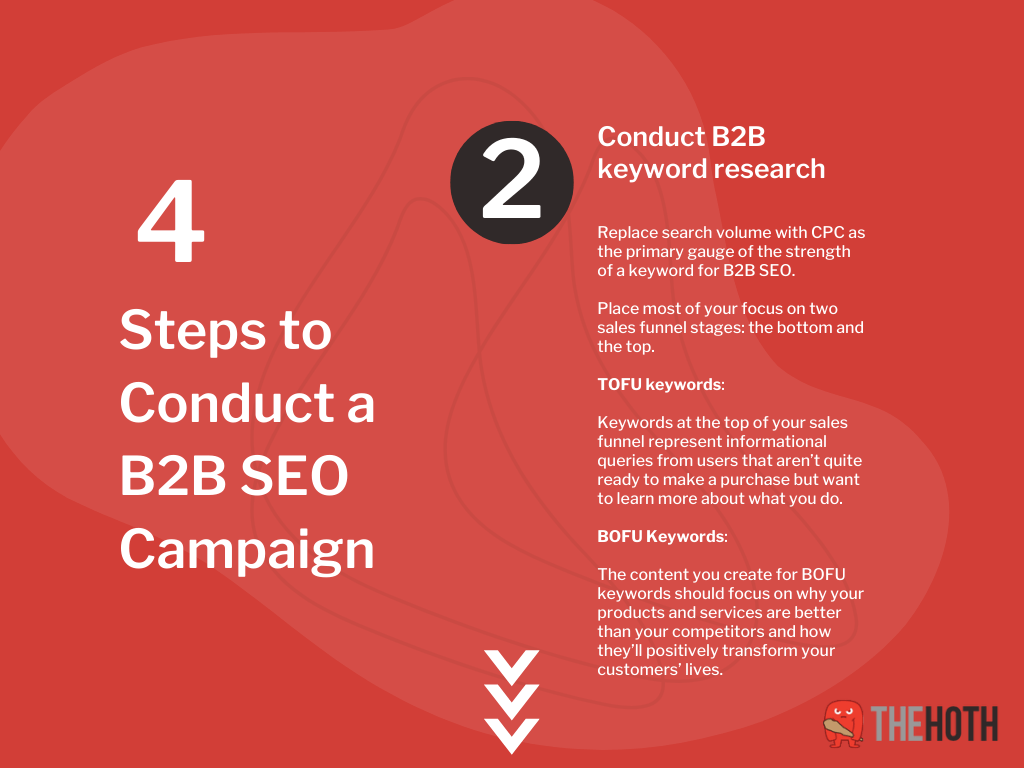
Conduct B2B keyword research
Once you have a detailed decision-maker avatar (or avatars if you serve multiple industries), you can move on to the keyword research phase.
Bear in mind that B2B keyword research looks a lot different than B2C.
For one, high search volume isn’t what you’re looking for – as you’re after specific long-tail keywords that key decision-makers in your niche use.
Even if a keyword only has a search volume of 10, if it’s relevant to your decision-maker personas, it can be worth pursuing.
Another noticeable difference is that the keywords you target should have a high CPC (cost-per-click).
While B2C keyword research looks for lower CPCs, a higher CPC for a B2B keyword means generating traffic from it will yield more value.
In other words, you should replace search volume with CPC as the primary gauge of the strength of a keyword for B2B SEO.
Also, you should place most of your focus on two sales funnel stages: the bottom and the top.
Why is that?
It’s because top-of-the-funnel (TOFU) keywords will establish your brand as a thought leader in your field, and bottom-of-the-funnel (BOFU) keywords are the most important for landing conversions.
If you only focus on BOFU keywords, generating enough traffic to raise brand awareness and develop new leads will be difficult.
If TOFU is your primary focus, you’ll miss out on more immediate sales you could generate through BOFU queries.
That’s why it’s crucial to use a balance of both.
TOFU keywords
Keywords at the top of your sales funnel represent informational queries from users that aren’t quite ready to make a purchase but want to learn more about what you do.
They could want to learn a new skill at first, causing them to come across one of your ultimate guides.
Should you attempt to convert the reader into a customer on a TOFU blog?
Not yet, as that’s too aggressive.
Instead, the CTAs for your TOFU blogs should contain lead-generation tools like mailing lists, newsletters, or free eBooks.
You can use our free keyword planner to uncover informational queries relevant to your niche. While B2B SEO tends to focus on keywords with lower search volumes, your TOFU keywords should have a higher search volume (although not quite as high as for B2C keywords).
TOFU keywords tend to include the following phrases:
- How-to
- Why
- What is
- Benefits of
- Tips for
- Guides on
Another way to find TOFU keywords is to look at the type of content your top competitors produce.
For instance, if you discover that a #1-ranked competitor has a how-to guide that has thousands of clicks, comments, and shares on social media – you could create a similar guide that provides even more value by going into more detail.
Lastly, the website Exploding Topics is excellent for finding trending TOFU topics, just be sure to choose a category that reflects your niche.
BOFU keywords
Keywords at the bottom of your sales funnel represent queries from users that are looking to make a purchase.
As such, they don’t need to consume any how-to guides or educational blogs to get to know your brand.
Instead, the content you create for BOFU keywords should focus on why your products and services are better than your competitors and how they’ll positively transform your customers’ lives.
Common types of BOFU content include:
- Case studies
- Customer reviews
- Testimonials
- Use Cases
- White papers
- Video demos and tutorials
- Pricing pages
- Product roundups
Also, the CTA for each piece of content should link to one of your product or service pages instead of a lead generation tool.
That way, you’ll be able to secure as many conversions as possible from customers searching for exactly what you sell.
BOFU keywords tend to include the following terms:
- Buy
- For sale
- Discount
- Near me
- Cheapest
- Subscribe
- Download
- Register
- Membership
Remember to look for low search volume and high CPC whenever you use a keyword research tool for BOFU keywords.
Why does high CPC matter for B2B SEO?
It’s because the cost-per-click represents how much people are bidding on Google Ads for a specific keyword.
The higher the CPC is, the more valuable the keyword is to pursue.
Even if the keyword has a minuscule search volume, a high CPC is a reliable indicator of its marketing power.
By combining TOFU and BOFU content, you’ll enjoy the best of both worlds by generating new leads and converting new customers simultaneously.
Create a B2B content calendar
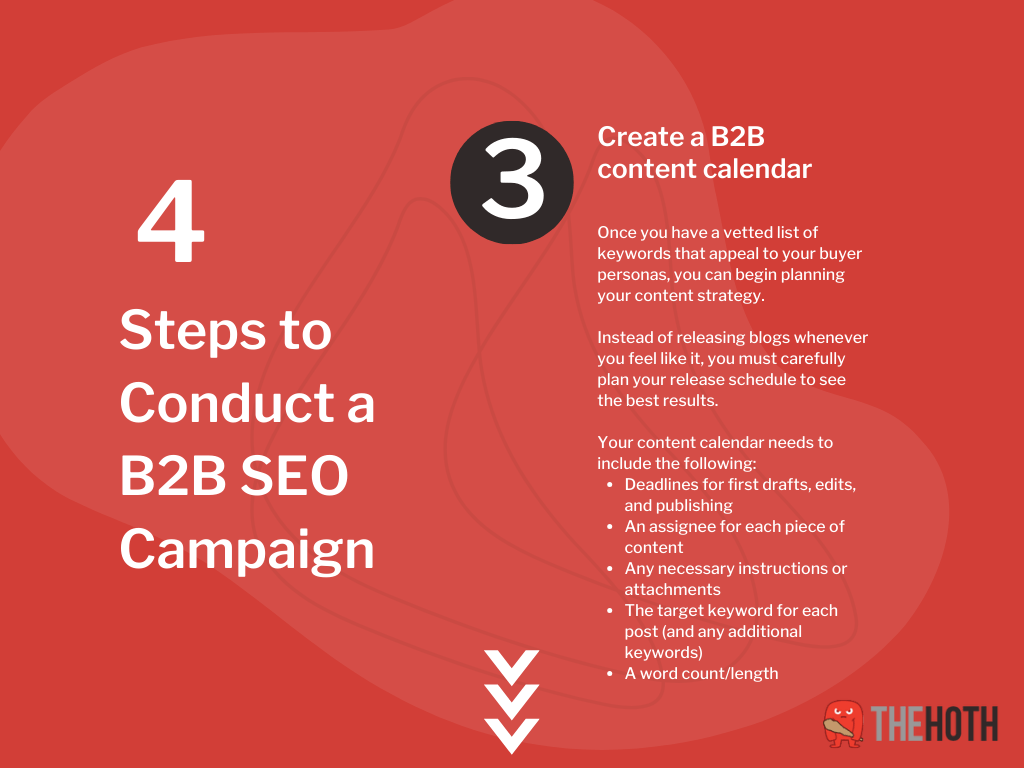
Once you have a vetted list of keywords that appeal to your buyer personas, you can begin planning your content strategy.
Instead of releasing blogs whenever you feel like it, you must carefully plan your release schedule to see the best results.
The first step is to establish clear goals for your content.
What do you hope to achieve with your content, and when do you want to achieve it?
Give yourself a clearly defined goal with real metrics and a timeline, like improving customer acquisition by 20% within 14 months.
Also, ensure that you have ways to measure your success, such as monitoring your traffic, rankings, and conversions using tools like Google Search Console and Google Analytics.
Next, map out a typical sales cycle for one of your customers using real data.
On average, how long does it take for a prospect to convert into a paying customer? How many pieces of thought leader content do they consume before moving down the sales funnel?
This is all crucial information to know when developing a content calendar.
After that, it’s time to make your content calendar a reality by using software like Excel or a project management tool like Asana.
Your content calendar needs to include the following:
- Deadlines for first drafts, edits, and publishing
- An assignee for each piece of content
- Any necessary instructions or attachments
- The target keyword for each post (and any additional keywords)
- A word count/length
Once your calendar contains all these elements, it’s ready to go live.
Build authoritative links for your new pages
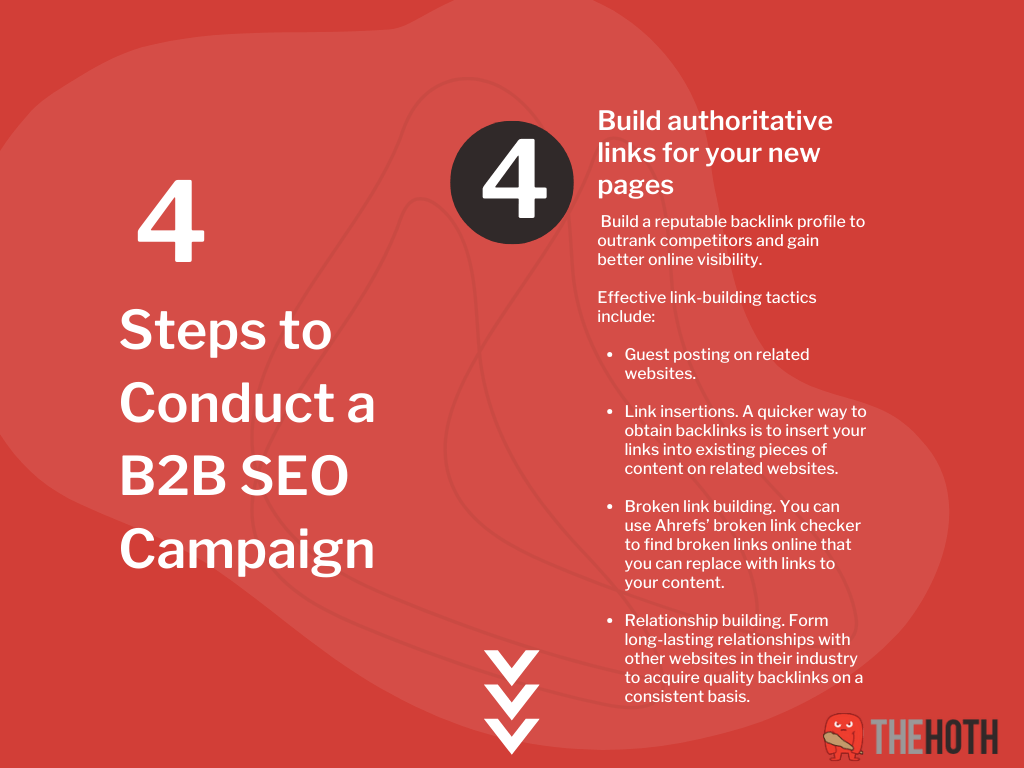
Most of the time, releasing high-quality content isn’t enough to help you reach the very top of the SERPs.
Instead, you’ll also need a reputable backlink profile to outrank competitors and gain better online visibility.
Also, you don’t want to generate backlinks from just any website, as that can actually backfire if they aren’t reputable. You should only target backlinks from trusted websites that have high domain authority scores.
Effective link-building tactics include:
- Guest posting on related websites. Publishing guest blogs on relevant websites in your niche is a great way to acquire links pointing back to your most important pages.
- Link insertions. A quicker way to obtain backlinks is to insert your links into existing pieces of content on related websites.
- Broken link building. You can use Ahrefs’ broken link checker to find broken links online that you can replace with links to your content.
- Relationship building. Hailed as the new way to get links, many SEOs are opting to form long-lasting relationships with other websites in their industry to acquire quality backlinks on a consistent basis.
Concluding Thoughts: B2B SEO Strategies
A B2B SEO strategy may look a lot different than B2C, but the fundamentals remain the same.
Your goal is still to generate leads and conversions through high-quality, keyword-rich content with strong backlinks.
The primary difference lies in appealing to business leaders instead of the general public, but once you get the hang of that – you’ll be off to the races.
Do you want to form a successful B2B SEO strategy for your business?
Then you need to check out HOTH X, our managed SEO services that have yielded outstanding results for countless clients.
